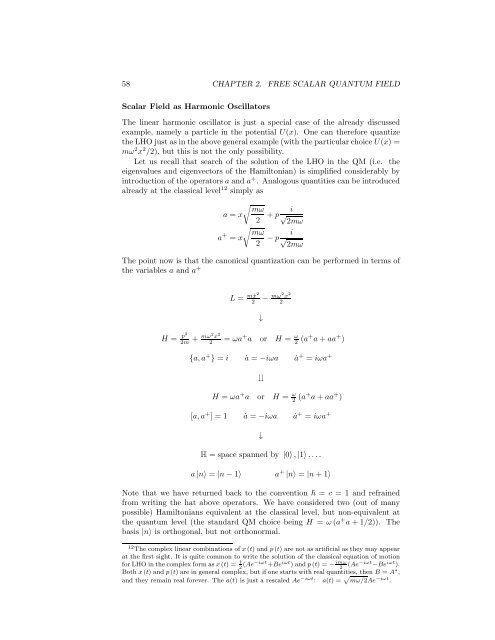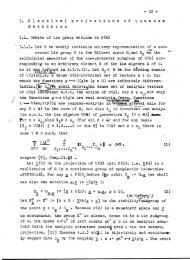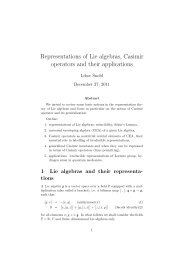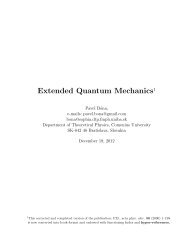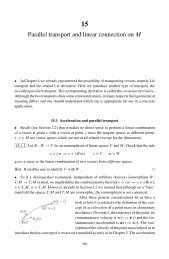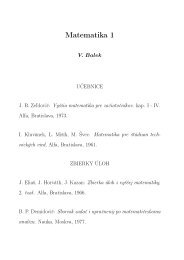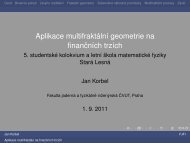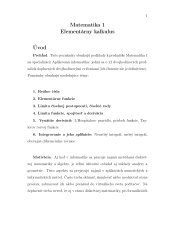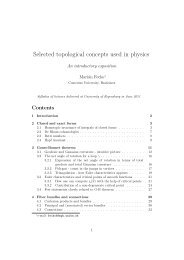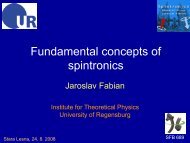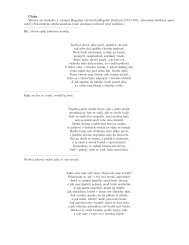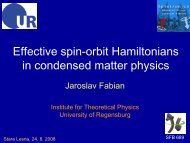Quantum Field Theory I
Quantum Field Theory I
Quantum Field Theory I
Create successful ePaper yourself
Turn your PDF publications into a flip-book with our unique Google optimized e-Paper software.
58 CHAPTER 2. FREE SCALAR QUANTUM FIELD<br />
Scalar <strong>Field</strong> as Harmonic Oscillators<br />
The linear harmonic oscillator is just a special case of the already discussed<br />
example, namely a particle in the potential U(x). One can therefore quantize<br />
theLHOjust asin theabovegeneralexample(with the particularchoiceU(x) =<br />
mω 2 x 2 /2), but this is not the only possibility.<br />
Let us recall that search of the solution of the LHO in the QM (i.e. the<br />
eigenvalues and eigenvectors of the Hamiltonian) is simplified considerably by<br />
introduction of the operators a and a + . Analogous quantities can be introduced<br />
already at the classical level 12 simply as<br />
√ mω<br />
a = x<br />
2 +p i<br />
√<br />
2mω<br />
√ mω<br />
a + = x<br />
2 −p i<br />
√<br />
2mω<br />
The point now is that the canonical quantization can be performed in terms of<br />
the variables a and a +<br />
L = mẋ2<br />
2<br />
− mω2 x 2<br />
2<br />
H = p2<br />
2m + mω2 x 2<br />
2<br />
= ωa + a or H = ω 2 (a+ a+aa + )<br />
↓<br />
{a,a + } = i ȧ = −iωa ȧ + = iωa +<br />
<br />
H = ωa + a or H = ω 2 (a+ a+aa + )<br />
[a,a + ] = 1 ȧ = −iωa ȧ + = iωa +<br />
↓<br />
H = space spanned by |0〉,|1〉,...<br />
a|n〉 = |n−1〉<br />
a + |n〉 = |n+1〉<br />
Note that we have returned back to the convention = c = 1 and refrained<br />
from writing the hat above operators. We have considered two (out of many<br />
possible) Hamiltonians equivalent at the classical level, but non-equivalent at<br />
the quantum level (the standard QM choice being H = ω(a + a+1/2)). The<br />
basis |n〉 is orthogonal, but not orthonormal.<br />
12 The complex linear combinations of x(t) and p(t) are not as artificial as they may appear<br />
at the first sight. It is quite common to write the solution of the classical equation of motion<br />
forLHO inthe complex formas x(t) = 1 2 (Ae−iωt +Be iωt ) and p(t) = − imω<br />
2 (Ae−iωt −Be iωt ).<br />
Both x(t) and p(t) are in general complex, but if one starts with real quantities, then B = A ∗ ,<br />
and they remain real forever. The a(t) is just a rescaled Ae −iωt : a(t) = √ mω/2Ae −iωt .


